Niki Lauda is among the top Formula 1 drivers in history and has three world championship titles to his name, but he wasn’t an F1 star right from the get-go. Early on in his career, Lauda had racing success in various cars and series including Formula Vee and Formula Three. But he didn’t stand out as the next great choice for the pinnacle of racing: F1.
Four years after he began racing, Lauda took out a personal loan to buy his way onto the March Formula Two team as a pay driver in 1971.
Once at March, Lauda’s incredible driving skills quickly got him promoted to Formula One but he could not find much success with the young team. In 1973 Lauda took out another loan to buy his way onto another team – the 1972 world championship winning British Racing Motors (BRM) – though the team was overextended and in decline after what was its final world championship the previous year.
When former BRM teammate Clay Regazzoni rejoined Ferrari in 1974 after only one season with 17 grand prix-winning team, he sang Lauda’s virtues – leading to none other than Enzo Ferrari immediately signing Lauda with the Prancing Horse.
Ferrari changed everything. Now that Lauda was on a team that matched his skill with its engineering prowess, his career took off. By the very next year – 1975 – Lauda won his first world championship title, proving he just needed a good enough car to match his abilities.
The right driver in the right car is simply a winning combination, and Lauda’s 1975 season proved that a proper match could lead to greatness.
Racing nerd side note: There are two types of drivers in professional auto racing: a paid driver and a pay driver. A paid driver is what it sounds like: a driver paid by the racing team to drive its cars, contracted and paid a yearly salary. A pay driver is the opposite: a driver that pays a racing team (either with his or her own money or a sponsorship from a brand or manufacturer) for a spot to drive on the team with no direct compensation. This practice, allowing drivers the chance to race even if they might not have the skills or credentials to warrant a contract, infuses teams with extra capital. These are sometimes referred to as ride buyers or gentlemen drivers.
What does Lauda have to do with Zenith? Nothing except that I wanted to use his career as an example of how finding the right partner can lead to real perfection.
The same, of course, goes for watchmaking where at times a specific movement or case-and-dial combination can stand on their merits but still leave us with the feeling that something is just missing.

Zenith Defy El Primero Double Tourbillon in forged carbon
This brings to mind the stunning and technically fantastic Zenith Defy El Primero Double Tourbillon. Based around a previous technical achievement from LVMH sibling brand TAG Heuer, the Defy El Primero Double Tourbillon is the best of two worlds married into a seriously winning combination.
Zenith Defy El Primero Double Tourbillon: tourbillons rotating at different speeds
It feels appropriate to have compared this watch to Lauda’s career as once he joined Ferrari he had a long relationship with Heuer (later TAG Heuer). The double tourbillon mechanics inside the Zenith Defy El Primero Double Tourbillon are the result of research and development at TAG Heuer.
Since both brands are under the umbrella of LVMH, and the recently created TAG Heuer Institute now oversees research and development for TAG Heuer, Zenith, and Hublot, the connection was just waiting to be made.
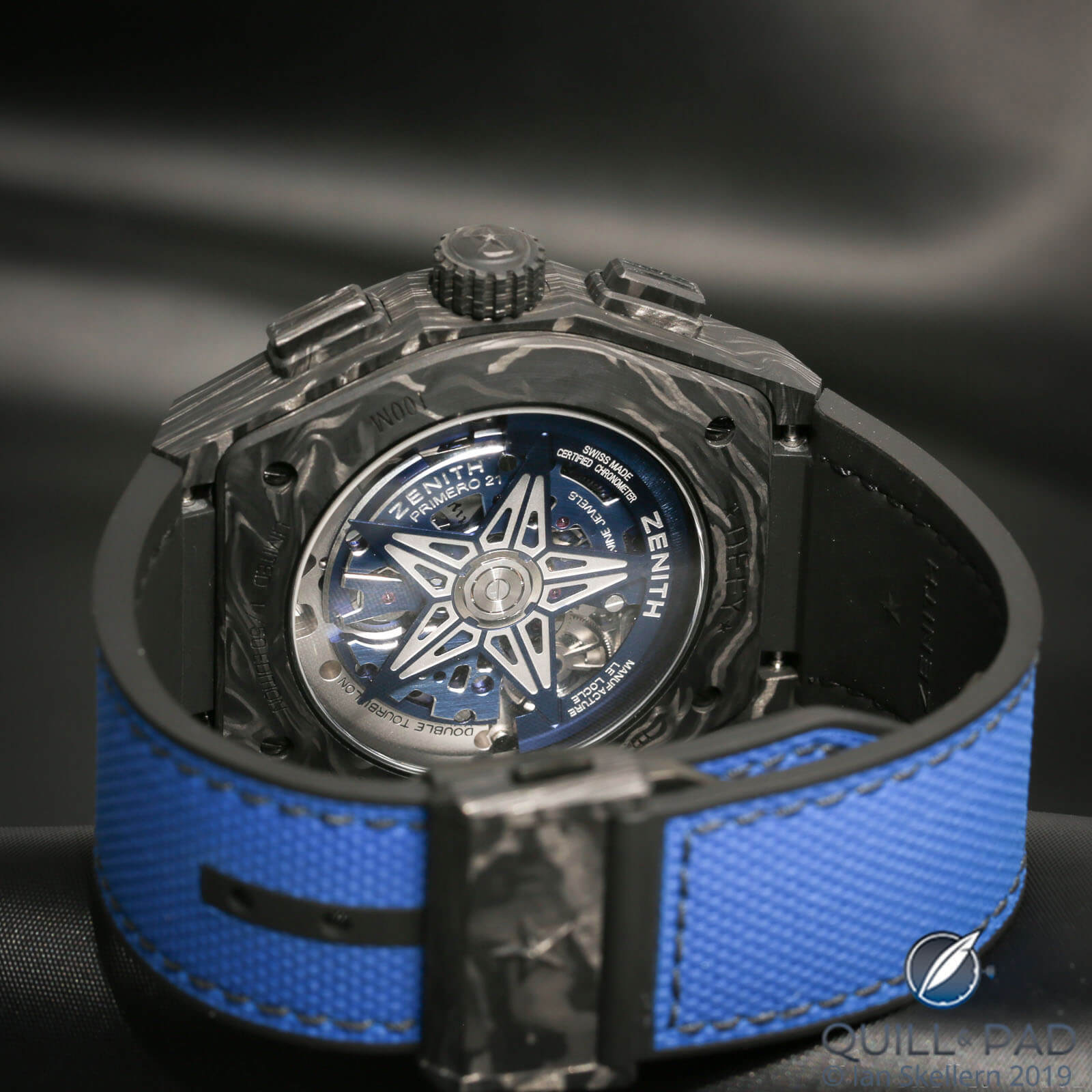
Striking rotor in the shape of Zenith’s star visible through the display back of the Zenith Defy El Primero Double Tourbillon in forged carbon
The Defy El Primero Double Tourbillon is based on the chronograph movement originally found in 2012’s TAG Heuer MikrotourbillonS (an awesome watch), with a key update that makes it wholeheartedly an El Primero.
The El Primero Caliber 9020 features two independent tourbillons that rotate at drastically different speeds for very different purposes. The tourbillon visible at 8 o’clock connects to the main going train to consistently dole out time measurements at the standard El Primero frequency of 36,000 vph (5 Hz).
This is an increase over the 4 Hz of the TAG Heuer movement since the El Primero legacy is built on the one-tenth-of-a-second accuracy that was considered a high-frequency movement. It still is, with one of the benefits being it provides a very smooth and much more consistent rate thanks to the high frequency and stable oscillations of a smaller and lighter balance.
But one-tenth of a second is still a pretty granular division when undertaking precision timing, and that is why the movement is designed with two independent tourbillon mechanisms so that the chronograph can achieve something a bit better – by a factor of ten.
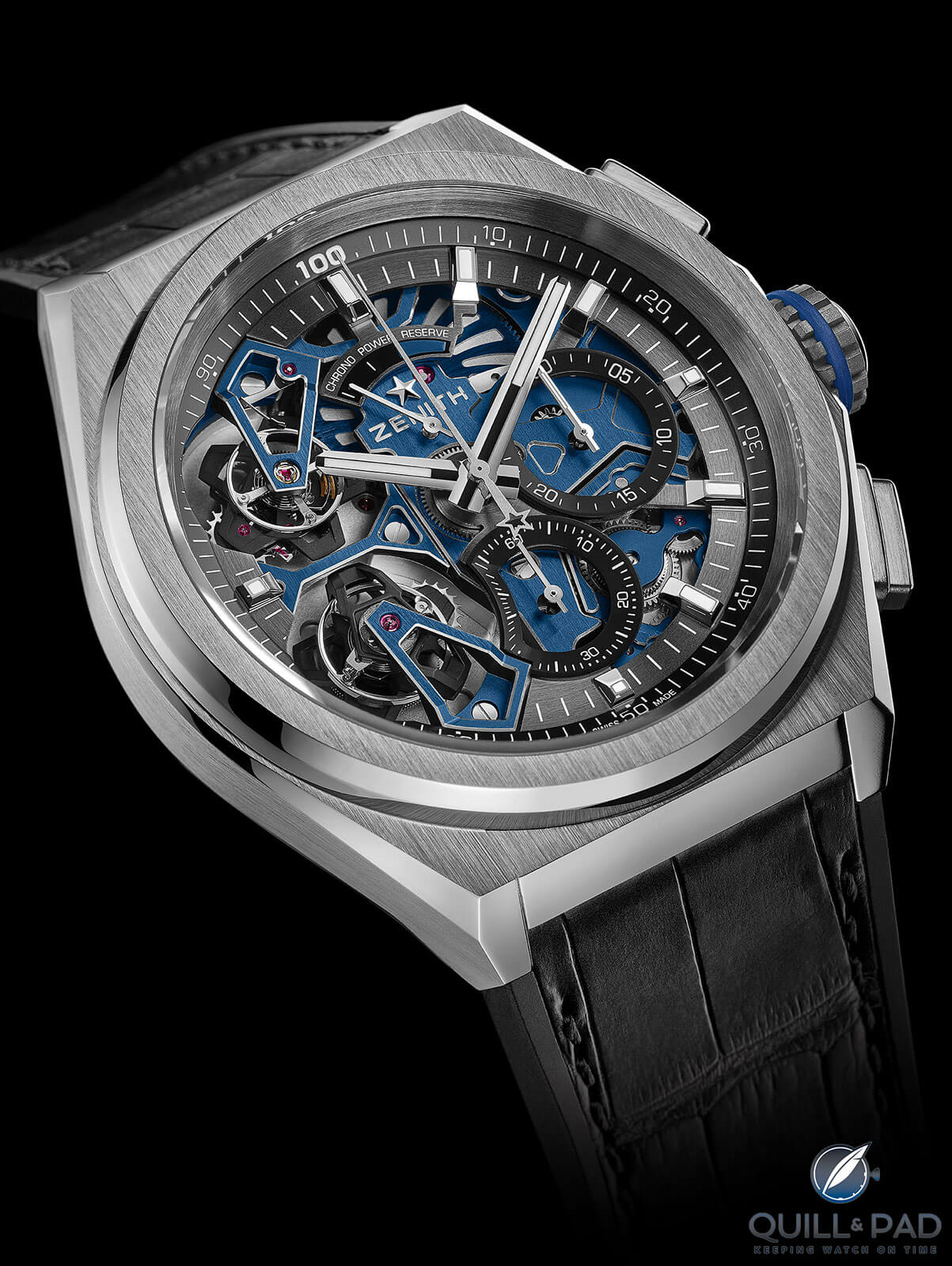
Zenith Defy El Primero Double Tourbillon
The tourbillon at 10 o’clock connecting to the chronograph mechanism is a high-speed variation with a smaller balance that oscillates at a frequency of 360,000 vph (50 Hz), ten times faster than the other tourbillon positioned just a millimeter away.
That frequency leads to the chronograph measuring time to 1/100th of a second (ten times faster than the going train is able). This means that the long sweep chronograph hand is a one-hundredth-of-a-second hand that makes one rotation every second with a secondary subdial to measure individual seconds.
The separate regulator and wicked speed have some distinct advantages over the typical chronograph including a finer scale for more precise sub-second measurements (within the limits of reaction time) and no influence on the going train and time display.
But it does come with one major drawback: it is a huge energy hog.
Zenith Defy El Primero Double Tourbillon: context makes sense
The chronograph runs on a separate mainspring barrel than the going train; thanks to its ten-fold increase in speed there is a reduction of power reserve by 60, though. When fully wound, the main going train runs for 50 hours, while the chronograph can only run for 50 minutes, meaning that you can’t even time a full hour. Therefore there is no need for a chronograph hour indication.
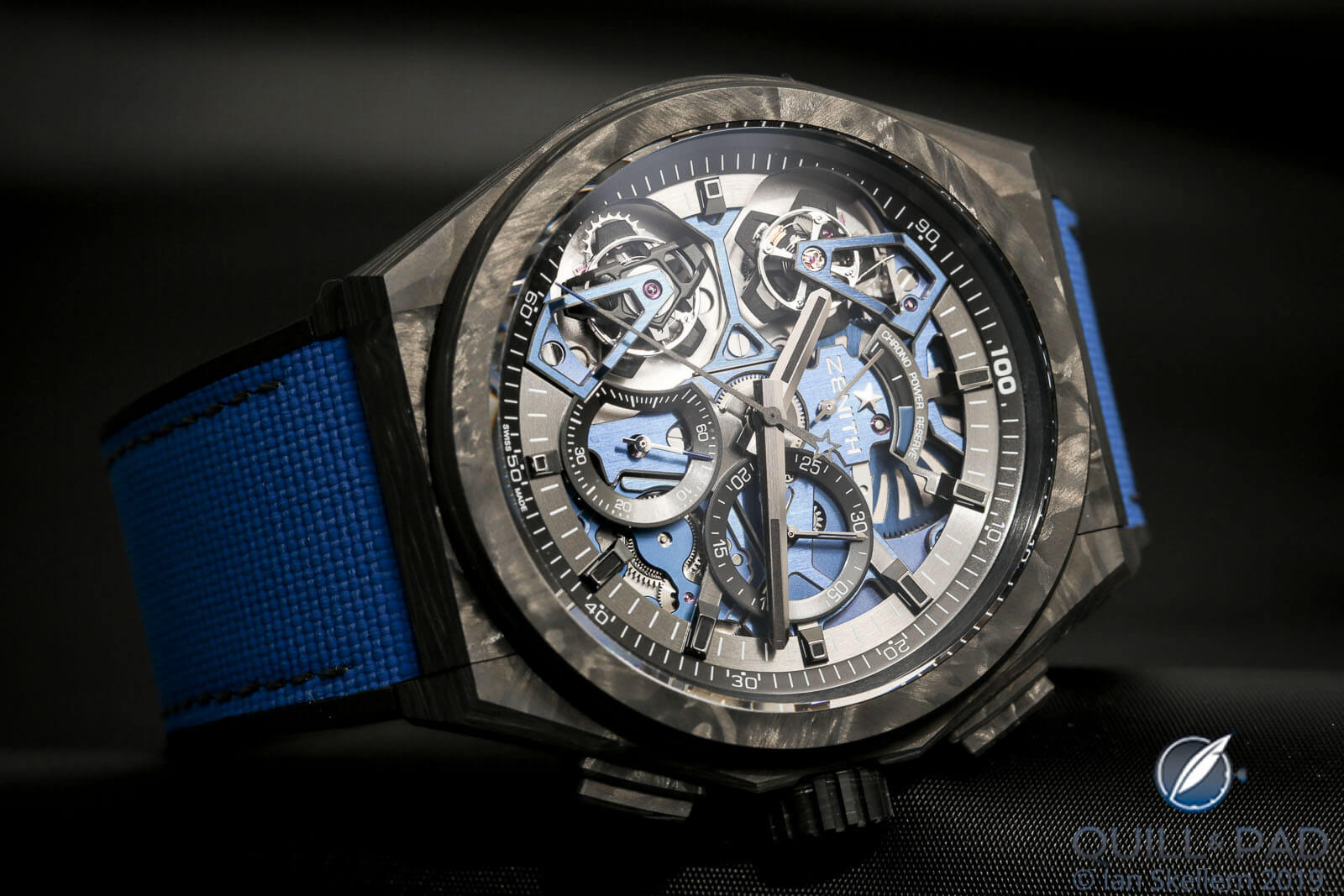
Zenith Defy El Primero Double Tourbillon in forged carbon
The chronograph mechanism has a power reserve indicator at 12 o’clock to help remind the wearer that it’s draining fast and you better hurry what you are timing.
No matter, though, the extra precision to 1/100th of a second means that you probably aren’t using it to time long events like a marathon and instead are timing fast, short events like the 100-meter dash. This kind of echoes the historical differences, at least to me, between TAG Heuer and Zenith wristwatches.
Even though TAG Heuer created iconic chronograph wristwatches to measure things like the Carrera Panamericana and the Mille Miglia (which might take a while) and made specialty timing stopwatches accurate to 1/100th of a second, Zenith was the first to make a wristwatch accurate to one-tenth of a second, cementing the name Zenith and El Primero with chronographic precision for everyone.
And that fact alone makes the Defy El Primero Double Tourbillon akin to Niki Lauda and his 1975 Ferrari.
This double tourbillon movement always made sense in a TAG Heuer from a technological standpoint as it fit with the ethos of producing top-notch timing instruments. But placed in a Zenith it fills the role of the enthusiast watch for those slightly more critical of their timepieces.
All of this is generally pointless with modern timing techniques and the rapid progress of technology, but the connection feels right for the ideology behind Zenith.
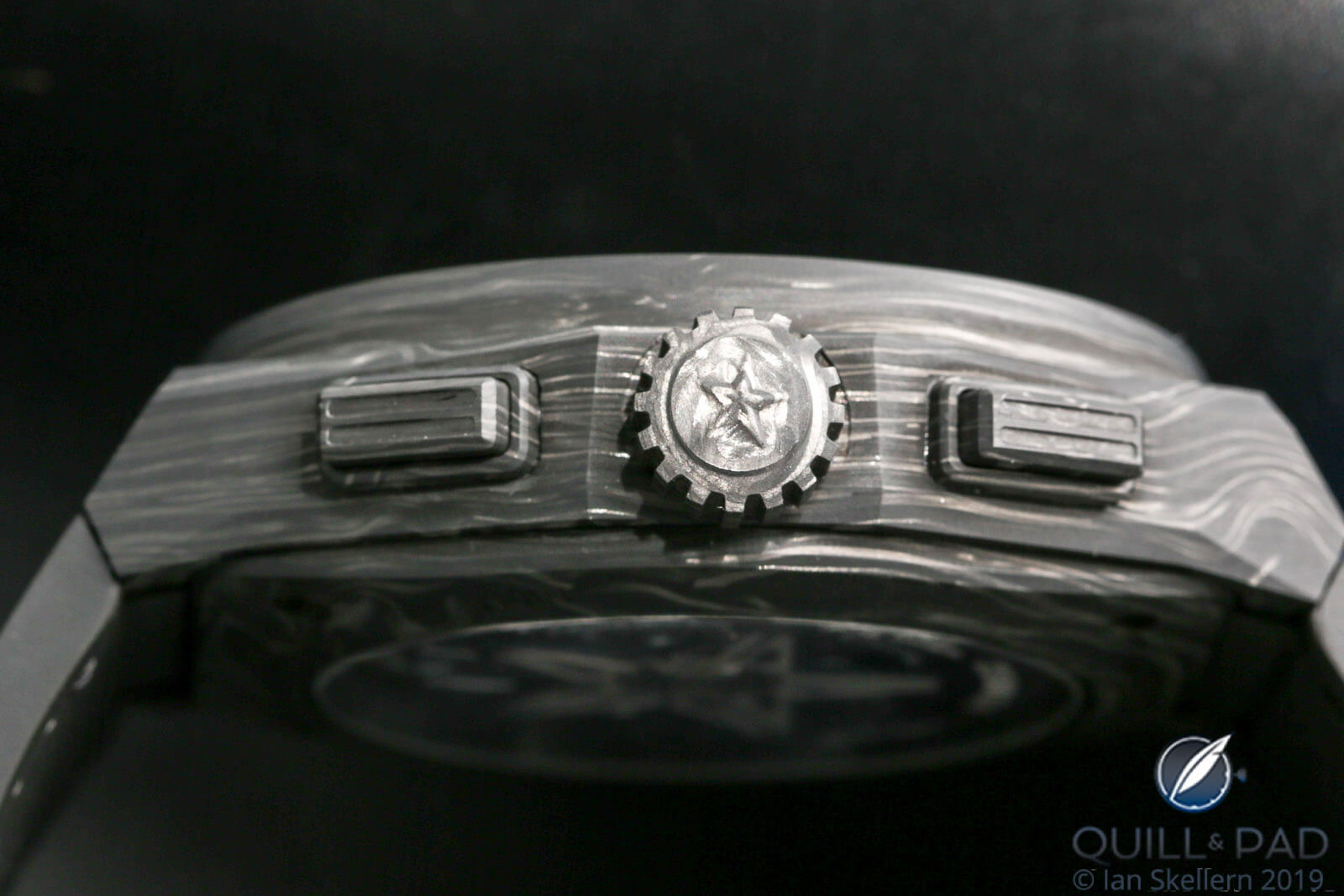
Forged carbon crown and chronograph pushers of the Zenith Defy El Primero Double Tourbillon
Fifty years ago, the types of people that bought Heuer were looking for useful tool watches, machines that served a purpose and could be used hard and keep on working.
But for Zenith you could take that same purpose and add a premium for the El Primero movement, which was a bit more precise when used for measurement and (depending on whose version of history you are reading) possibly the first automatic chronograph of its kind.
Regardless if it was or wasn’t first, the fact that the El Primero held a bit of a cachet, and still does, didn’t change.
Putting aside the fact that Zenith decided to create this new movement with a semi-skeletonized dial (a questionable choice when it comes to legibility), the function holds true to the roots of the brand back in the 1960s and early 1970s to provide that something extra over the competition.
In this case it is ten times extra, but who’s counting (I am, I’m counting!).
And I am suspending rationality when considering this watch as a truly useful timing companion, when it really is about how the precision makes you feel about the incredible mechanics inside.
Watches like this can be simply for inspiration just like the Ferrari Niki Lauda drove to victory in 1975.
This watch is still incredibly expensive, though it also is about half the price of the original MikrotourbillonS back in 2012, making it something of a rather good deal (seen relatively). But in the end, the research and development from TAG Heuer that has been shared with Zenith has led to a great combination.
If future models look to more subdued styling or something that prioritized legibility, the Defy El Primero Double Tourbillon could be without any glaring flaws.
But I don’t actually care if it has that legibility flaw because using awesome mechanics that could easily have been forgotten or shelved indefinitely is always a preferred outcome to me.
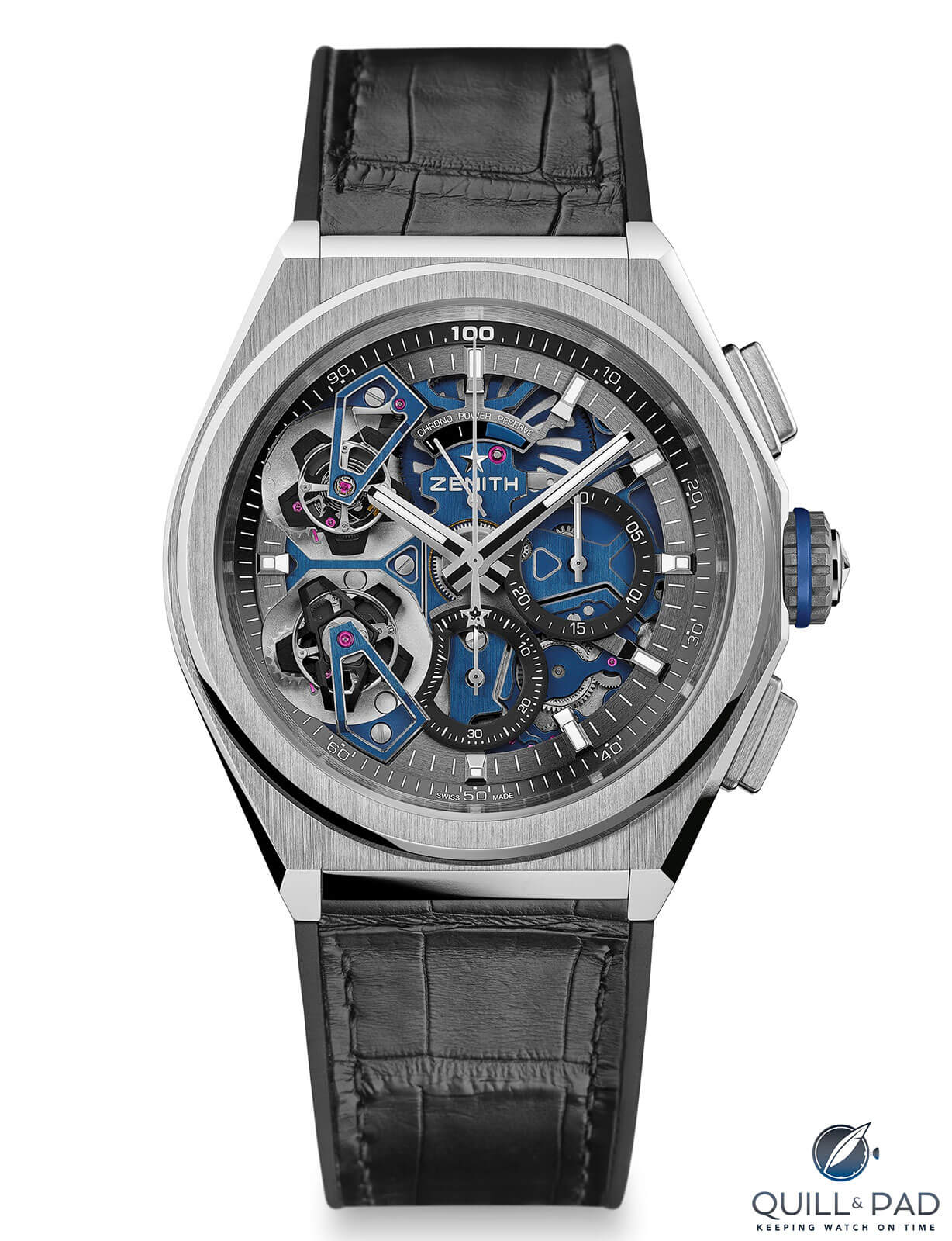
Zenith Defy El Primero Double Tourbillon
And when brands find something that makes sense in different configurations, I urge them to explore that. It could be that the only thing holding an idea back is the implementation.
The Defy El Primero Double Tourbillon, at 46 mm and in either platinum or forged carbon, is not for the faint of heart and definitely asks for attention. But when you have a tourbillon rotating once every five seconds and counting off hundredths of a second, well, that deserves to be seen.
On that note, let’s see the breakdown!
- Wowza Factor * 9.2 That double tourbillon chronograph is hard not to say wow to!
- Late Night Lust Appeal * 92.0» 902.212m/s2 Some serious power, all coming through that 50 Hz tourbillon!
- M.G.R. * 70.3 It may be an update to a movement first released seven years ago, but it really never gets old!
- Added-Functionitis * Moderate It has a chronograph power reserve that is very useful when the chronograph whirls through its power reserve in 50 minutes! I’d say this watch requires extra-strength Gotta-HAVE-That cream for some super-fast horological action!
- Ouch Outline * 10.2 Chewing on your cheek when you are numb from the dentist! It doesn’t actually hurt right away but an hour later when the Novocain wears off, the inside of your cheek feels like raw hamburger!
- Mermaid Moment * 5 seconds! By the time the 50 Hz chronograph tourbillon makes one revolution you’ll be ready to call the reverend!
- Awesome Total * 771 Take the frequency of the chronograph tourbillon in Hz (50) and multiply by the diameter of the case (46), then divide by the frequency of the regular tourbillon in Hz (5), finally add the number of components in the El Primero 9020 movement (311) for a speedy awesome total!
For more information, please visit www.zenith-watches.com/en/defy-double-tourbillon.
Quick Facts Zenith Defy El Primero Double Tourbillon
Case: 46 x 14.5 mm, platinum or forged carbon
Movement: automatic Caliber El Primero 9020 with two independent tourbillons, one revolving at 5 Hz and one at 50 Hz, 5 Hz/36,000 vph and 50 Hz/360,000 vph frequencies, 50-hour and 50-minute power reserves, officially certified as a chronometer by Timelab
Functions: hours, minutes; chronograph showing seconds and minutes to 1/100th of a second; chronograph power reserve
Limitation: 10 pieces in platinum, 50 pieces in forged carbon
Price: $113,000 in forged carbon, $141,000 in platinum
You may also enjoy:
Zenith Defy Inventor: Experimental Compliant Tech Goes Into Serial Watch Production
Exceptional Movements In History: Zenith El Primero
Zenith Defy Zero G: A Lesson In Miniaturization
The Zenith Defy Lab Highlights Technology That Could Change Future Watchmaking
Leave a Reply
Want to join the discussion?Feel free to contribute!





















































Hermoso
Lo quiero